Thinking of replacing your lead acid or AGM batteries in your RV Camper (travel trailer, 5th wheel, house portion of a motorhome)? Have you ever spoken with a salesperson about getting RV batteries who has told you “sure, just drop in your Lithium battery into your RV camper/trailer and you’re good to go”?
When it comes to being an RV’er and switching to lithium batteries, think there’s MORE to the story? Well… there most definitely is! Let’s dive in and look at what is REALLY involved in switching to Lithium batteries in your camper. AND, NO, Lithium batteries are NOT just “drop in” if you want to get top performance out of these INCREDIBLY expensive batteries AND if you want to ensure you don’t DAMAGE YOUR CAMPER or truck (if you’re in a trailer.)
First some background on batteries – Types of RV batteries
For your camper you want a battery that can deliver moderate amounts of electric current (measured in amps) for prolonged periods of time. In my world, this takes the form of a deep cycle “golf cart” or marine battery. This is in contrast to the starting batteries which are used to start a car, truck, or motorhome. Starting batteries provide a burst of energy needed to start your vehicle; deep cycle batteries as noted earlier provide power for a prolonged period of time.
Regardless of whether you have a motorhome (where we’re talking about the “house” battery(s) or a towable (travel trailer or fifth wheel), currently there are just 3 primary types of batteries available: flooded lead acid, AGM, and lithium. Lets take a brief look at each:
Flooded lead acid batteries
These are the “tried and true” RV batteries that have been in use for decades. Affordable and reliable BUT they do require routine “maintenance” as you have to check and add distilled water periodically. Some say monthly, but this has not been my experience. I check about 3-4 times annually and it takes a matter of minutes to check and fill. My batteries have lasted nearly 6 years to date, but everyone’s experience will differ depending upon climate and camping style. I full time in my camper and dry camp about 30 days each year.
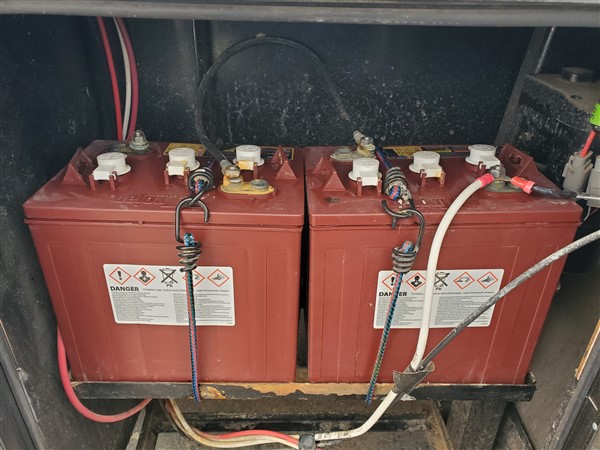
Lead acid batteries come in 12 volt and 6 volt “flavors.” I was once advised by someone “in the know” that the ONLY true deep cycle marine batteries are 6 volt “golf cart” type batteries. For this reason, I have a pair of 6 volt batteries wired in series. This produces 12 volts, as required by the camper.
I chose to go with Trojan 105 batteries as they have an outstanding reputation (and as noted earlier, have provided great service for me.) US Battery (model 2200) also has a good reputation. I’m learning that Duracell (EastPenn) are also worth considering. The12 volt Interstate “deep cycle” battery is the most common choice made by RV dealers to install because they’re cheap and readily available.
UPDATE: I just put in service a pair of Duracell 6 volt deep cycle (lead-acid) batteries yesterday! These are the 235AH “flavor” (they also make 230 and 215AH models.) Duracell are made by EastPenn, and are sold to Batteries Plus (this is the retailer, located in Idaho Falls, Id) whom I chose – I’d give them 5 stars by the way! You can also get the two lower power models at Sam’s Club. I chose Batteries Plus over Sam’s Club because they are battery specialists AND their inventory was fresher.
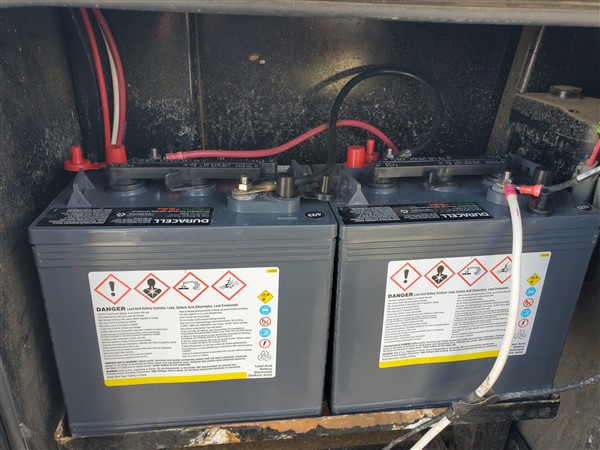
Additional “good stuff” to know –
- lead acid batteries are heavy (60 – 65 pounds is not unusual)
- they work in a WIDE range of temperatures. You DO need to take care in cold weather, if they slip below 60% charge, they *could* freeze and at temperatures below -4F, one source I encountered when doing my research for this article indicated they won’t function. PERSONAL EXPERIENCE: I would have to state clearly that I’ve spent winters where for periods of weeks the overnight temperatures slipped to -20F or lower and the batteries functioned well. I was however hooked up to “shore power” (electric power pedestal) for the entire time and the batteries remained connected in a non-heated, open air compartment.
- These batteries can be discharged to 50% before any damage occurs. This means if the batteries are 230 amp-hours, they have a usable 115 amp-hours before you must charge them or risk damage*
- These batteries must be used in the enclosure designed for them as they do emit hydrogen and hydrogen sulfide gas as they function – this is why all enclosures are vented in one manner or another
- When placed in storage (if you do), they lose about 5% of their charge per month – a word to the wise: don’t let them slip below 60% if they’re in a cold storage area!
What’s an Amp-hour?
*A quick note on “amp-hours”, lets say you are dry camping and have a draw of 10 amps each hour, in 11 hours you’ll have drawn 110 amp-hours (10×11=110.) This would drain a 230AH lead acid battery by about 50% at which point it MUST be recharged.
Will you draw 10 amps continuously for 11 hours? Perhaps if you’re running your furnace, and a couple of other electric components/appliances, but I offer this simply as an example to understand what an “amp-hour” is. See my section on charging batteries to consider this point further.
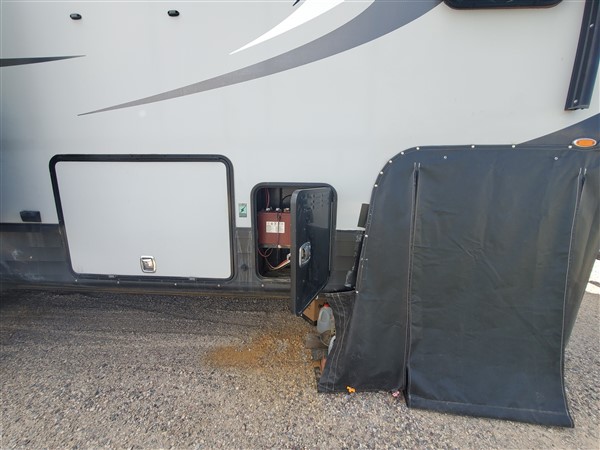
AGM Batteries
Absorption glass mat (AGM) batteries are a newer design to batteries, available since the 1980’s. They are MAINTENANCE FREE (ie – no adding water) and may even withstand even lower temperatures than a lead acid battery. AGM batteries tend to cost about TWICE as much as lead acid batteries. For this reason alone, I’m not a fan of AGM as the number of amp hours is equivalent to lead acid, but the cost is much higher. In the AGM world, Renogy does make a highly regarded battery. This Renogy battery is 100 amp-hours, so you’re likely to want at least two, and its priced right (click link to see the current cost.)
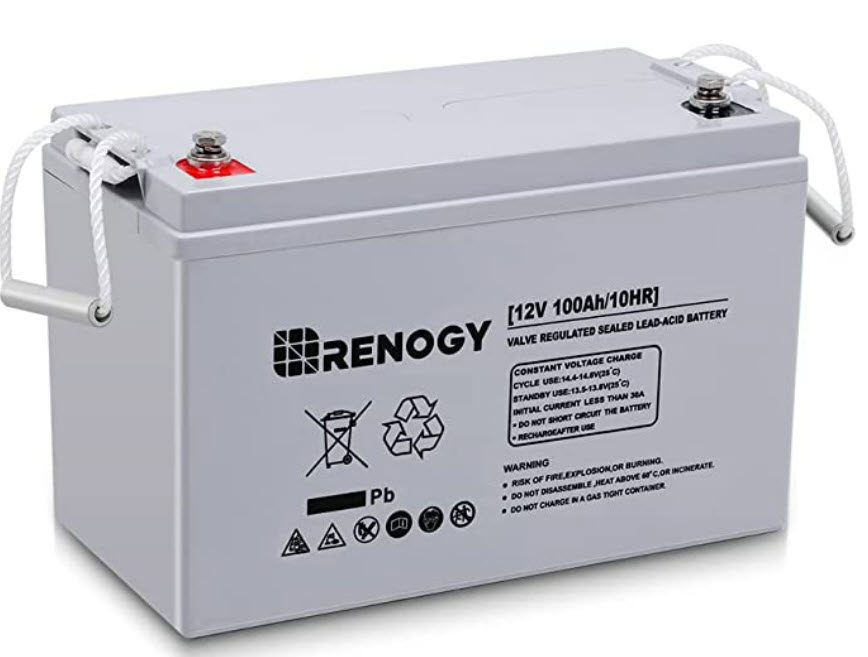
They are also as heavy as lead acid. Their functional temperature range is similar to a lead acid, but they’re less prone to freezing. They DO require more voltage to charge them than a lead acid and as such may require a change in the charge converter (or just “converter”.) More about this device shortly!
AGM batteries just like lead acid batteries can not be discharged more than 50% without risking damage. If placed in storage (attention part timers!) they will discharge, like their lead-acid cousins, but they discharge at a slower rate. They are however more temperamental to charging and can be damaged if you overcharge them.
Lithium Batteries
Lithium RV batteries are the new kid on the block and many rv’ers are considering employing them for their camper – hence the reason for this article! BEFORE you purchase lithium batteries, be sure to read the “rest of this article” as I tell you what you NEED TO KNOW to make an informed decision.
Lithium batteries are EXPENSIVE – Battleborn, Lion Energy, and Renogy all tend to sell for about $900. for a 100 amp-hour battery. BUT as you’ll read below – there ARE additional expenses you’ll encounter. I will get into the chemistry of Lithium batteries (and compare them to those made for vehicles) later in this article.
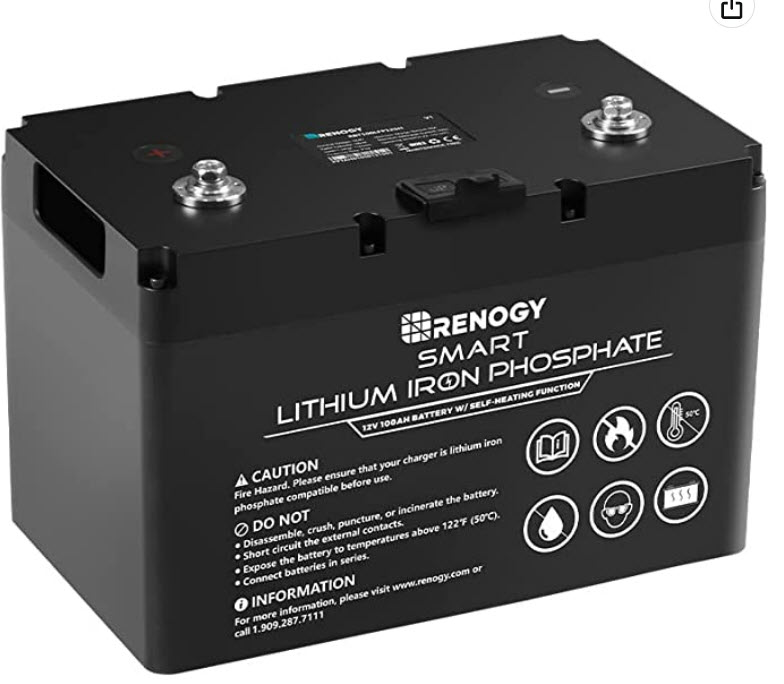
The arguments FOR Lithium batteries include
- lightweight (generally 25-30 pounds)
- maintenance free
- lots of charging cycles (manufacturers claim about 3000, compared to 1000 for lead acid and AGM)
- Hold their output at 13.1-13.3 volts all through discharging process compared to lead acid and AGM that start at 13.3 and drop gradually to 12.0, at which point they’re 50% discharged and must be recharged (see below)
- Can be discharged to about 90% (some say 100%) – but – you need to monitor this as the voltage holds over 13 volts, until it doesn’t! In other words, there’s little advance warning in contrast to lead acid.
- Since they can be discharged 90%, you don’t need as many amp-hours to get the same performance as a lead acid or AGM type battery.*
- They do not outgas at all so they can be relocated somewhere else inside your camper – BUT – that’s assuming you have the space to mount AND wire them from that location
- they charge faster than lead acid or AGM batts
*Some quick math here: If your lithium battery is rated at 100Amp-hours, you get about 90 usable amp-hours from it. A 200 amp-hour lead acid (or AGM) battery will give you 100 usable amp-hours before it is 50% discharged (which is the maximum safe discharge for these types of batteries.)
The arguments AGAINST lithium batteries include
- Temperature sensitivity – they won’t charge if the temperature is below freezing
- They just won’t function at -4F or lower
- They are also useless if the temperature exceeds 135F (note: the air temperature doesn’t have to reach this level, only the temperature inside the compartment they’re stored in – not such an unreasonable assumption in some parts of the nation in the summer)
- There ARE additional costs involved even though the battery sales guy said “oh, just drop them in to replace your existing batteries and you’re good to go” (THIS IS POTENTIALLY A DEAL BREAKER – read on…)
How RV batteries charge (and why you NEED to care)…
I’ve talked about amp-hours here. This is essentially the delivering of energy or electric current (measured in amps) over a period of time (in this case, hours.) All batteries discharge over time, whether in use or in storage. When in use, you can recharge your batteries in a number of ways:
- From “shore power” (120 volts, AC current) – this is the same whether its a power pedestal at an RV park or from a generator. The camper is connected to the power source and from there AC (alternating current) electricity travels to the “converter” (or charge converter) and is converted to about 12 volts DC (direct current.) The DC output is then sent to the RV (house) batteries. As long as you’re connected to “shore power”, your batteries are kept at or near fully charged. Most of the better converters are 3 stage, able to vary the voltage being sent to the batteries to keep them fully charged without OVER charging them – which can damage a battery. NOTE: Lithium batteries require a converter designed to work with lithium batts. This means, when you get lithium batteries, you may need to change your charge converter – read on for more details.
- From solar panels which are best connected directly to the batteries with only a “solar controller” inline to ensure the batteries are not OVER charged. My solar setup is detailed HERE. Note that my solar suitcase has a weather proof solar controller built into it.
Special note: If you’re dry camping and need to run the furnace all night, you’re placing a big demand on your batteries. Furnaces draw about 8 amps (or more) per hour. Add to that any of the following: lights, a laptop, your fridge, etc. and you’re easily over 10 amps per hour. Do the math and you can see its easy to drain a small RV battery system (like my two 6 volt Trojan 105’s – or my new Duracell’s) in just one night*. One action that will change the equation is to run a generator (for at least a few hours) overnight, BUT you then have two new concerns: the generator may run out of fuel and it creates noise – which may not go over well if you have neighbors!
*Do the math: If you draw 10 amps per hour for 9 hours, that’s 90 amp hours, remember, a lead-acid or AGM battery only has a “usable” amp-hours at 50% of the rating. So… in my case, with 235 AH on my new Duracell’s, they will be 50% discharged when they have provided 117 amp-hours of energy. If I draw 10 amps per hour for 9 hours, I’m getting close!
In my experience, I RARELY draw 10 amps per hour while dry camping. But it all depends upon what you want or need to operate.
A quick note on Dry Camping (boondocking)
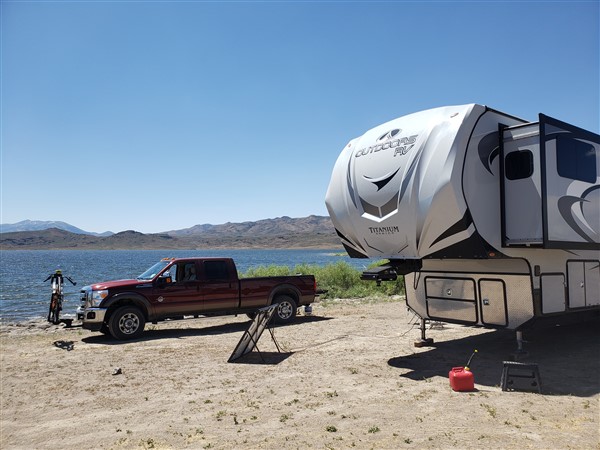
Give some advance thought to what you need or want to operate while dry camping (no shore power available) and how you plan to charge your batteries (eg: solar? generator?) The more components/appliances you plan to operate, the greater the demand. The system I designed for myself was based upon the goal of keeping my batteries charged and using (primarily) only low-wattage appliances (eg: laptop, cell phone charger, TV, fridge), with little (or no) need to run the furnace.
I find that between June and September, there’s plenty of solar energy provided to the panels each day (as long as the sun is out!!) to ensure the batteries are at 50% or higher (ie – fully discharged) by the next sunrise.) For those with greater energy needs, you’ll want to consider a larger battery bank (ie – more storage.) This is why some RV’ers instead of having 2 6 volt lead acid batteries as I do have 4, 6, 8 or even more.
Example: If I needed more energy, I could have purchased a bank of 4 Duracell’s and I would have a total of 270 AH available. These are then wired in series-parallel. (There are plenty of videos that provide advice on how to wire such a system.)
Do Lithium batteries for RV’s have the same issues as some lithium batteries have had for cars? A little Lithium battery chemistry (don’t worry, I’ll be gentle)
The lithium battery you’ll purchase for your RV Camper is a LiFePO4 battery. In english, that means lithium iron phosphate. The iron is the key. It creates a chemically stable compound which is NOT prone to catching fire, emitting excess heat or exploding.
Lithium batteries for vehicles tend to use cobalt or manganese instead of iron in the chemical formulation and THOSE are the batteries that have produced some headline grabbing fires and explosions. So… long story short, Lithium batteries for RV’s are generally regarded as safe. That said, nothing has a 0% risk of fire or explosion.
“HIDDEN” expenses you will LIKELY encounter when migrating to lithium batteries
This section is a BIG deal and THE main reason I’m NOT switching to Lithium batteries for my 5th wheel rv camper.
As noted earlier, lithium batteries are expensive. And they’re not really “drop in replacements” for your existing lead acid or AGM batteries. Here are the additional expenses you should expect to encounter when you install lithium batteries (some of which the rv battery salesman may not even know about!)
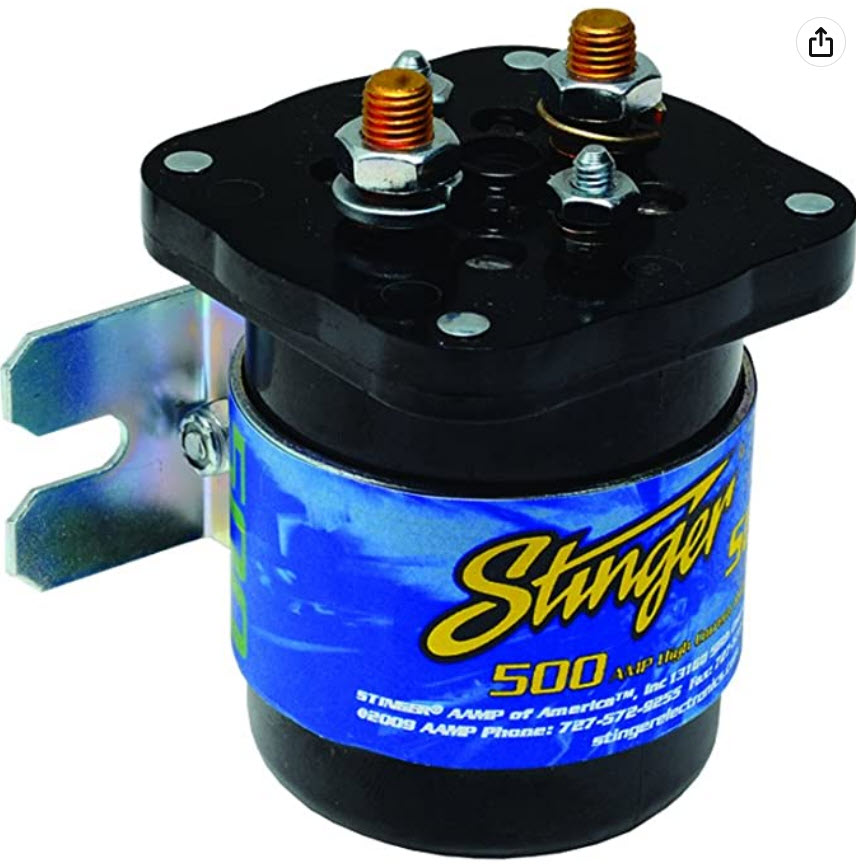
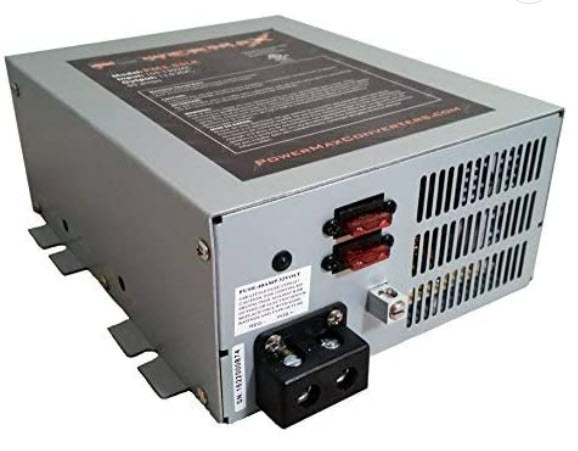
- Charge converter – As noted earlier, this is the device that converts 120 volts AC to DC voltage. Because lithium batteries charge differently from others, your current converter may not be designed to work with lithium. Most converters made before 2021 are NOT and WILL need to be replaced. Two converters that WILL work are the Powermax PM3-55LK and Progressive Dynamics Mighty Mini 4000 (replaces the entire breaker box.) Costs range from $170 to 270. plus installation. Figure you’ll be into a mobile rv service guy for at least $75. (plus the house call fee) to get these things installed (and potentially wired) in.
- Battery Monitor – Lithium batteries produce about the same output voltage until they’re nearly depleted. As a result, you need a monitor to know how far they’re discharged. The best monitor is the Victron Energy BMV-712, which costs about $200. Less expensive options can be obtained for perhaps $70. less that the Victron 712. This is in contrast AGM and lead acid which decline gradually as they approach their 50% discharge limit, so a simple volt-meter can determine the degree of discharge.
- Battery Isolator Relay – The Stinger SGP-35 is a highly reviewed 500 amp device that will protect your vehicle’s alternator from the strong current demand that a depleted lithium battery will cause. If you own a towable and simply connect your 7 pin plug to your trailer, you could damage your vehicles alternator if you don’t use a battery isolator relay. Cost: about $90 plus install
- Upgraded wiring – In many cases the wiring from the battery to the junction box may need to upgraded to as thick as 2 gauge (at least 4 gauge.) This is done in order to handle the current draw of the lithium battery (which again can be far greater than a lead acid or AGM.) Cost for the wire AND labor to rewire could easily approach $400. This figure could be higher if you choose to relocate your battery to a warmer or more secure location.
IF I do go for Lithium RV Batteries – which would I choose?
The top 3 names in the industry are Battleborn, Lion Energy, and Renogy (in my humble opinion!) Click on each in the prior sentence to learn about each manufacturer and model.
Am I planning to move to Lithium batteries?
As I noted earlier, NO! In fact, by the time you read this, I already chose a new set of lead-acid batteries. My current pair lasted nearly 6 years, so I have NO complaints!
The FUTURE of RV Batteries – technologies “on the horizon” or in development
Its possible that lithium batteries may be outdated before they really catch on! Do some research on sodium ion batteries. Sodium Ion batteries are still in the research/early development stage. This much is known: Sodium is far more abundant than lithium, therefore costs are MUCH lower. Once developed and released, costs could compare to or be lower than lead acid batteries.
Next, and this is REALLY speculative. Low energy nuclear reaction batteries. I’m no expert, but this may be (finally) an outgrowth of the 1989 Pons and Fleishmann experiment. Published findings indicated Pons and Fleishmann produced nuclear fusion energy in a coffee cup. While their work was widely denounced by the scientific community in 1989, these researchers may in fact have been onto something. The more recent low energy nuclear (fusion) reaction or LENR technology may be along similar (or the same) lines.
Either way, if and when this technology becomes commercially viable, it is environmentally clean and produces virtually limitless energy! Time will tell if a “low energy nuclear reaction rv battery” is in our future! But for now, I’ll stick with lead-acid batteries for my RV camper!
Note: If and when LENR batteries become available, this technology will literally change everything – and be applied to everything, far beyond RV’s and campers!
I hope this post provided value to you and welcome your thoughts. Comments can be left below. Also – please consider joining my newsletter for notification of upcoming posts.
The links in this post lead to Amazon affiliate links. Purchasing through these links costs you nothing extra and the funds generated help to defray my website costs.
Allan, Thank you for your very good videos. I have only recently come across your posts by way of MeWe. I know I had visited your RVAcrossamerica in the past but that was only through specific searches. Two things have come up in my mind watching and readding your posts. Number one is the discussion about 12 volt vs higher voltage. My Solar array system uses 24 volts and if I had planned for it better, my inverters would have been 24 volt inverters instead of 12volt Using 24 volts on the roof means I do not have to run extra heavy wire into the camper to accommodate the higher amperage. Inverters at 24 volt for the same reason. Any MPPT controller will connect the 24 volt Solar to charge 12 volt batteries. I currently have Four 12 Volt AGM batteries at 200Amp Hours each. On a regular basis (often) these seem to get drawn down to about 11.4 volts during my night time and rainy day, usage. I have a back bumper mounted inverter Generator which sits on foam to keep vibration in the camper to a minimum. The second item I noticed is that the LP tank boox on your camper is insulated by teh skirt from the bottom, but not at the door. The same for your side boxes. I highly recommend that you take some of your left over foam from last years skirting and glue to the inside of those doors.
Shipp,
Thanks for your thoughts. A couple of thoughts and questions –
– Is your inverter stepping your 24v system down to 12v (in order to run all the components in your camper that are designed for 12v)?
– If I recall my “electricity 101” in my college physics classes, higher voltage = less heat
– the greatest challenge you face is IF your batts truly are down to 11.4 volts at times (with NO load), you’re killing your batts (or you’ve already killed them) – they’re not supposed to drop below (about) 12.0volts (thats 50% depleted which is the LIMIT for lead acid and agm batts)
enjoy your travels
al
Al, I’ll probably go with your battery type recommendation. However, please clarify regarding a portable 24 volt lithium battery solar system. The Lion Energy system since they’re the only one of the top 3 litium batteries companies you mention that offers this. Can the voltage be stepped down to 12 volts via a switch on their power bank? In lieu of this, can this be achieved by integrating another device and if so what device? Would a 24 volt system have more versatilty with the potential to also power an off grid cabin and an RV when that’s a consideration? Or by “step it down” do you mean: If one bought a 24 volt system, it must be replaced with a 12 volt system for RV camping? Which often includes RV off grid/dry camping?
JP, I’m not an electrical engineer, but I can not think of a concrete advantage of installing 24 volt batteries into a camper made to run on 12 volts. Yes, there are step down converters, but again – why do this? As to lion energy, they make batteries for lots of applications, rv’s being only one of them. The battery I linked in my post is a 12 volt model. While they may very well offer 24 volt batts, I can’t think of a good reason to buy them for a camper. Al
I believe that Lion Energy, and perhaps other companies, make 24 volt lithium battery, solar panel, and power bank systems. Why are these largely ignored? What are the advantages and disadvantages of 24volt verses 12 and 6 volt systems? For RV dry camping, off grid cabins and emergency blackouts etc?
JP, most (if not all) campers are designed to run on a 12 volt system. This makes 6v (in series you generate 12v) and 12v batteries easy to use in a camper. If you purchased a 24 volt battery (none of the batteries I talked about in my post are 24v), you would need to step it down before introducing it to the systems in the camper. I can only speak to rv camping – yes, the batteries serve you when you’re dry camping or during power grid failures. Al